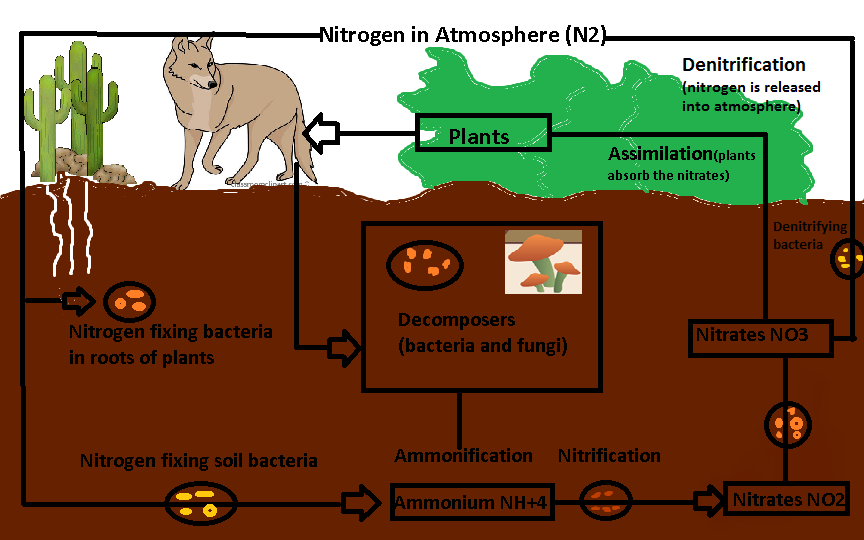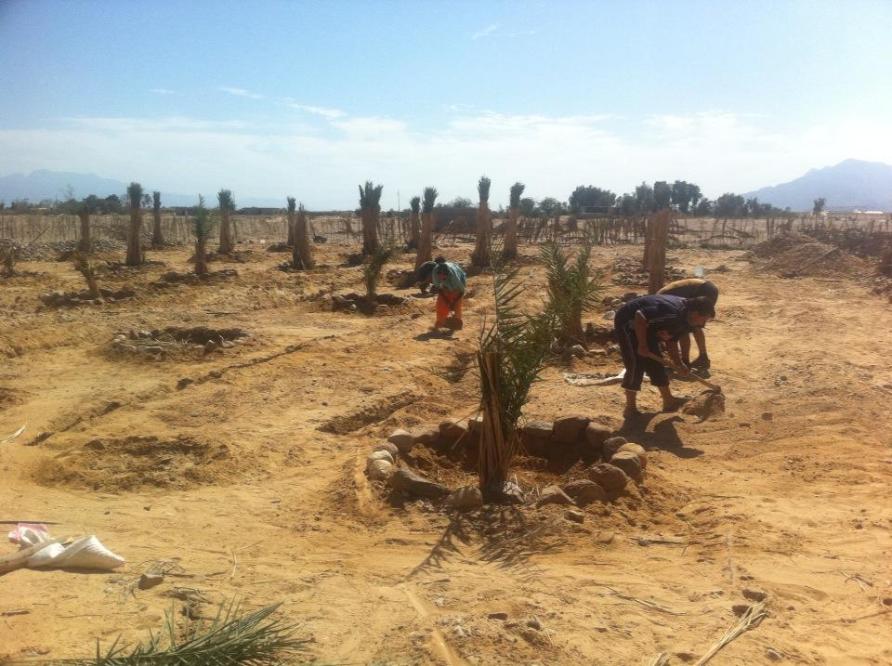Nitrogen Cycle in Desert Biome
The nitrogen cycle is where nitrogen moves between biotic and abiotic factors such as plants, animals, bacteria, soil, and the atmosphere. This cycle is very important because nitrogen plays a major role in cell processes such as amino acids, proteins, and even DNA. It is also needed to make chlorophyll in plants, which plants use to make food and energy. The first step of the nitrogen cycle is fixation, where bacteria change nitrogen into ammonium. (Most of the time the last stage lets ammonium reenter the cycle so the transformation of nitrogen into ammonium is not needed) Then, during nitrification, this ammonium is changed into nitrates by bacteria that can then be absorbed by plants. Next, during assimilation, plants absorb the nitrates from the soil into their roots. This stage is very important because plants need nitrogen to complete photosynthesis. Also, these plants are consumed by other organisms such as reptiles and insects. These creatures are then eaten by secondary consumers such as snakes and small carnivores. Before long the nitrogen bearing compounds from the plants are passed further up the food chain until they reach tertiary consumers such as coyotes and birds of prey. These nitrates play a major role for these animals in the desert because the nitrates regulate cell processes and are essential for life. When the tertiary consumers, the coyote and the birds of prey, die ammonification occurs. Decomposers including fungi and bacteria decompose the dead bodies of the tertiary consumers and convert the nitrogen from the dead bodies back into ammonium. This occurs so the ammonium can reenter and continue the cycle. At the same time as ammonification, denitrification allows bacteria to let extra nitrogen in the soil out into the atmosphere. Denitrification is the final stage of the cycle of the matter, nitrogen. Although matter and energy flow through an ecosystem, they do it quite differently. Energy decreases as it moves from one animal to the next and the highest animal on the energy pyramid dies with that energy. On the other hand, matter is recycled within ecosystems. As you could see with the nitrogen, the matter was transported from the soil to plants, and from plants to animals, and finally it was put into the soil again. It is one big continuous process that never stops. The way matter and energy flow through ecoystems may have some similarities, but they are also very different.

Humans Impact on the Desert
Humans have had a major impact on the desert over the past many years. One of the major threats in the desert area is land that is irrigated for agricultural purposes. This may provide water for the plants in the desert, but if not enough water is supplied in enough abundance to carry away salts on the land, the salinization of soil could occur. This means that salt levels have built up, and plants can not be supported. Another major issue is the grazing of animals. Grazing animals are often placed in deserts because they are there for a short time and receive supplemented food and water. As a result, this high level of grazing can kill an assortment of plant species in the area. Humans have even brought invasive species into the desert where they don't belong. Invasive plants are usually brought into the desert from different countries and threaten the space of native species that are indigenous to the desert. Off road vehicle use also poses a problem to the desert. Off road vehicle use is usually not just confined to one area, but is spread out across the desert. The soil ran over by the tracks of vehicles can succumb to erosion, and many plants killed by these vehicles take a long time to grow back again. Last but not least, global warming assisted by the carelessness of humans has a negative effect on the desert. Even small changes in the temperature and precipitation level of the desert can have extensive impacts on the plants and animals that live there. The organisms would have to adapt and evolve to the new changes in their environment. All of these negative impacts on the desert alter the equilibrium that exists there. When plants species are destroyed by humans, some species of animals that feed on these plants would have nothing to eat. This affects animals all the way to the top of the food chain. The balance in the desert is lost when humans participate in activities that harm the ecosystem existing within the desert biome. It is also very important that biodiversity exists, because everything in the ecosystem depends on each other to survive. For example, animals depend on various plants species and other animals to consume for energy. To keep this biodiversity within our desert ecosystem, many solutions have been introduced. We need to use water resources more efficiently to prevent salt levels from increasing, find ways to rotate crops to protect the soil, and use off road vehicles on only designated pathways and trails. These are just some of the ways to prevent the plants and animals of the desert being harmed, and can help maintain biodiversity and keep balance (equilibrium) within the ecosystem.
